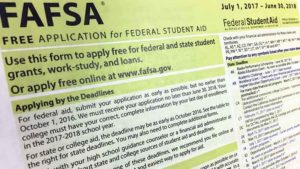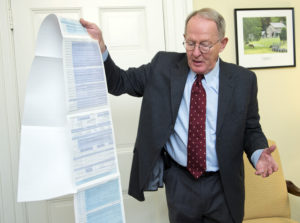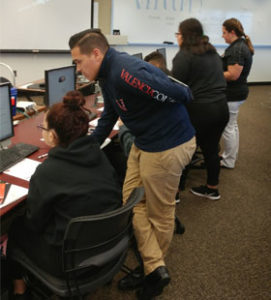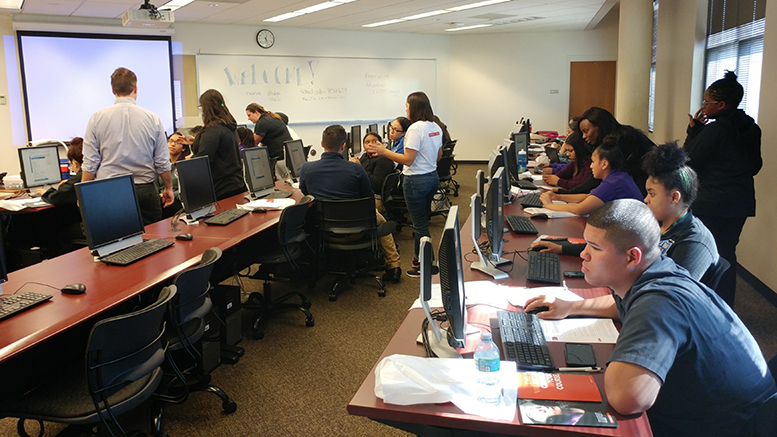If it wasn’t for federal financial aid, huge numbers of students would be shut out of college, yet it’s a continuing struggle for community colleges to persuade prospective students eligible for aid to fill out the Free Application for Federal Student Aid (FAFSA).
According to the National College Access Network, more than $24 billion of financial aid for higher education goes unclaimed each year.
“It’s hard to nail down why it’s happening,” says Megan Coval, vice president for policy and federal relations at the National Association of Student Financial Aid Administrators (NASFAA).
“A lot of it has to do with awareness,” Coval says. “Students don’t know financial aid is available, they don’t know what the FAFSA is and don’t fill out the form.” Some students don’t think they will be eligible or think only the lowest-income students can receive Pell grants, she added.
While high schools usually provide FAFSA sessions to seniors, older nontraditional students who comprise a sizeable number of community college enrollments tend to fall through the cracks. As a result, many community colleges make an extra effort to reach them at places like community centers, libraries and work.
An intimidating form
Another roadblock, Coval says, is “lingering intimidation about the form itself.”
While there have been recent attempts to simplify the complex and lengthy FAFSA, much more needs to be done, college aid officials agree.
Simplification of the FAFSA is a key items on the American Association of Community Colleges’ legislative agenda for the reauthorization of the Higher Education Act. (The House Education and the Workforce Committee may release it’s bill as early as next month.)
The U.S. Education Department has been making adjustments to the form to the extent that it can. One recent improvement has been to link the online form with tax data from the Internal Revenue Service, although that system was out of commission for several months this year following a hacking incident.
Another positive change is having the FAFSA available earlier – October 1 rather than January 1 – which gives students more time to plan to enter college in the following fall semester.
There’s been lots of talk on Congress about further efforts to simplify the FAFSA, Coval says. “The interest is there; the will is there. But there hasn’t been a vehicle to do it.”
One idea pushed by NASFAA is to allow anyone who qualifies for a means-tested federal program, such as Social Security benefits or the Supplemental Nutrition Assistance Program, to be automatically eligible for a Pell Grant.
“We need to stop having poor people keep proving they are poor,” Coval says.
Complicated families
Kelly Morrissey, financial aid director at Mount Wassachusett Community College (MWCC) in Massachusetts, suspects there are a lot of students eligible for financial aid who aren’t applying, but “it’s hard to quantify.” MWCC serves a large in-need population but only 60 percent of students file a FAFSA.
“There’s a mystique that the FAFSA is really complicated,” Morrissey says. But once students sit down for one-on-one assistance, “the majority find it’s much easier than they expected.” It often takes two or three sessions, however, if students fail to bring the required documents the first time.
The FAFSA is especially challenging for people with complicated family situations, Morrissey says, such as when students don’t meet the traditional definition of a dependent or an independent student.
Students have to be at least 24 to apply for aid as an independent student unless they are married, have children themselves, are in the military or meet other conditions. Students considered dependents have to submit their parents’ tax information.
 Examples of students who fall into a gray area include students who: receive tenuous financial support from parents; don’t have a fixed housing situation; and have been in foster care. Sometimes younger students have parents who are not supporting them or refuse to give their tax information. In other cases, students can get caught up in the middle of a custody battle between divorcing parents when neither one wants to pay for their education.
Examples of students who fall into a gray area include students who: receive tenuous financial support from parents; don’t have a fixed housing situation; and have been in foster care. Sometimes younger students have parents who are not supporting them or refuse to give their tax information. In other cases, students can get caught up in the middle of a custody battle between divorcing parents when neither one wants to pay for their education.
Those types of unfortunate situations are more likely to happen at community colleges, where there are students who lack parental support but still want to pursue higher education.
“We see this all the time,” Morrissey says. “It happens more often than you would think. A few times a week, the college sees students who do not fit neatly into the boxes.”
“We have some authority to override a student’s dependency status if there is a cycle of abuse or neglect and the student can document that,” she says. In other cases, if parents refuse to participate, a student can get a less favorable federal loan that accrues interest while they’re still in school, or they might be able to get some institutional aid that doesn’t require a FAFSA.
False assumptions
JoEllen Soucier, executive director of financial aid at Houston Community College (HCC), says many students don’t apply for financial aid because “they make assumptions that aren’t true.”
Students think they have to attend full time to qualify, and that if they are only taking two or three courses they have to pay out of pocket, Soucier says. One student thought she wasn’t eligible because she was working a lot of hours. Others think their parents are earning too much or they don’t qualify because they’re already getting veterans’ benefits.
In other cases, students assume they have a limited amount of funds they can borrow or receive as a Pell Grant and want to save it for when they transfer to a higher-priced four-year college. That’s not the case, however, as they don’t get the whole six years’ worth of aid at once.

Sen. Lamar Alexander (R-Tennessee), chair of the Senate Health, Education, Labor and Pensions Committee and a former U.S. education secretary, has championed to make the FAFSA simpler. In this 2014 photo, he rolls out the form to show how lengthy it is. (Photo: AP/Manuel Balce Ceneta)
“Dreamers” – students born in the U.S. but have immigrant parents who are undocumented – often don’t apply for aid because they fear their parents could be deported if they reveal their financial information on a government form.
Even when students submit a FAFSA, it can be flagged for various reasons which call for additional sessions with a financial aid counselor. And if those issues aren’t resolved, the application could be denied.
A FAFSA could be flagged if: an applicant doesn’t have a Social Security number or doesn’t enter the correct number; the student is not a citizen; a male is age 18 to 26 and failed to register for the selective service; or the student is a dependent and their parents’ marital status doesn’t match what’s on their tax forms. In some cases, a parent might have been working under the table, never filed taxes and doesn’t have a Social Security number, Soucier says.
A few years ago, HCC had a problem with students unable to get federal aid because they received a high school diploma or GED from a diploma mill, Soucier says. Those credentials were not considered valid for purposes of applying for financial aid.
There were about 2,000 affected students in 2014-15. HCC helped them get institutional grants so they could earn a legitimate diploma. Since the diploma mills were shut down, the problem has been resolved, and now there’s only about one or students a year who fall into that category.
Extensive outreach
At Valencia College in Florida, one of the problems facing financial aid counselors is the early deadline for filing a FAFSA, which is several months before the start of the fall semester.
“The stereotypical community college student decides to enroll three weeks before school starts,” says Daniel Barkowitz, vice president for financial aid and veterans’ affairs. By then it’s too late to apply for aid.
There are also several state aid programs that require a FAFSA, such as the Florida Student Assistance Grants. In many cases, it’s first-come, first-served, so the earlier students file a FAFSA, the better their chance of getting aid, Barkowitz says.
Valencia College sets aside a day when high school is not in session to bring high school students to the college for a “FAFSA Frenzy” event.
“Whether they enroll in our college or not, we want them to get their FAFSA done,” Barkowitz says.
Valencia participates in events hosted by the Florida College Access Network, such as the Florida FAFSA Challenge, which offers prizes to school districts that get the most students to complete a FAFSA.

Students get help filling out the FAFSA. (Photo: Valencia College)
The college also sends financial aid counselors into the high schools to walk students through the FAFSA and staffs a mobile lab provided by the Osceola County School District that brings information on student aid to community events.
Valencia has trained college students to serve as “financial aid learning ambassadors” to educate their peers on money management and general financial literacy, as well as completing the FAFSA. The students are paid through the federal work study program.
While recent high school graduates usually get some help from their guidance counselors, the FAFSA tends to be more challenging for adult students unaware of the filing deadline.
Mount Wassuchett staff “try to get the message out everywhere we think we can reach individuals interested in higher education,” Morrissey says, including community agencies, libraries, newspapers and social media.
Along with many other colleges and universities in the state, MWCC participates in “FAFSA Day Massachusetts,” a program sponsored by the Massachusetts Association of Student Financial Aid Administrators to help people apply for aid.
The publicity surrounding that event, as well as other efforts at MWCC, has led to an increase in FAFSA filings by about 5 percent for the current academic year, Morrissey says, even though enrollment is down by about 5 percent.
MWCC used to host weekly “FAFSA Fridays” during filing season but those sessions failed to attract enough students, so last summer the college made staff available in the student business center every day with no need for an appointment. That approach was much more successful.
Houston Community College also conducts a significant effort to promote financial aid awareness. A six-member coaching team conducts workshops at high schools, hosts FAFSA filing nights, gives presentations in student success courses, provides one-on-one help and spreads the word through social media.
All that has helped move the needle from about 44 percent of HCC students receiving aid to about 48 percent in the past four years, Soucier says.
Financial aid is critical, she says, because the inability to pay for college is one of the biggest barriers to enrolling and completing college.
“If we can remove the financial barrier to education, students can work on other barriers like academic readiness,” she says.

